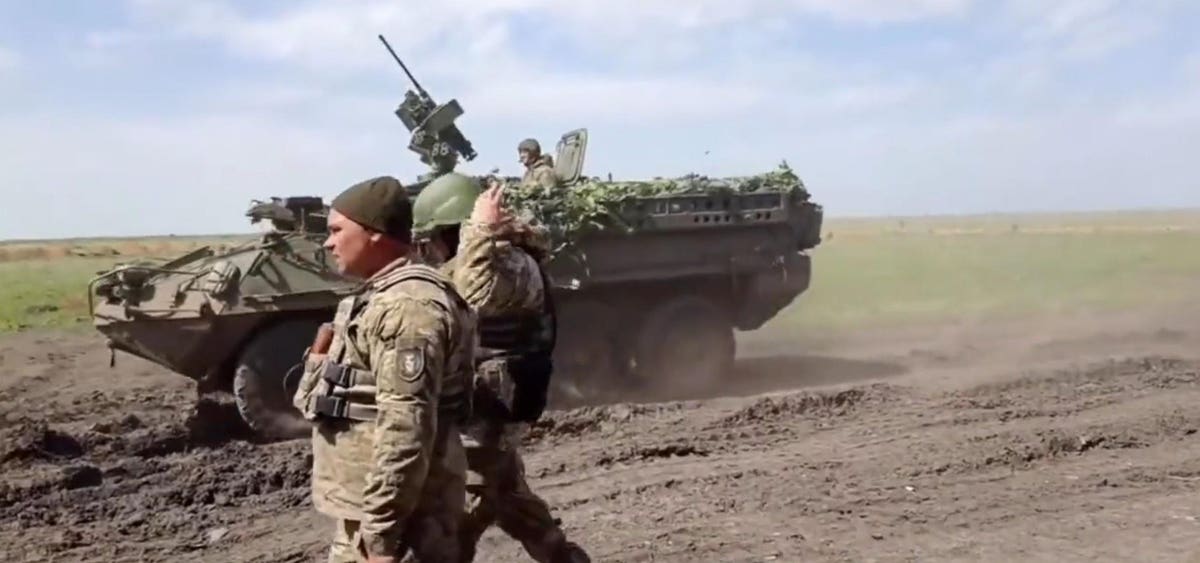Nearly six weeks into Ukraine’s long-anticipated 2023 counteroffensive, one of the Ukrainian military’s most powerful units—the new 82nd Air Assault Brigade—still hasn’t joined the fight.
But a video that appeared online on Friday is a reminder that the 2,000-person formation—with its 14 Challenger 2 tanks, 40 Marder tracked infantry fighting vehicles and 90 Stryker wheeled IFVs—is ready to roll into action at the time and place of Ukrainian commanders’ choosing.
Ukraine’s American allies have anticipated the day when the 82nd Brigade finally makes contact with the Russians. The United States already is sending fresh vehicles to replace the brigade’s eventual combat losses.
The Friday video depicts Strykers, apparently belonging to the 82nd Brigade, speeding along a dirt road presumably somewhere in southern Ukraine’s Zaporizhzhia Oblast, the locus of the counteroffensive.
The 82nd’s vehicles—plus the two dozen 105-millimeter howitzers that support them—together form a potent assault force. One that could breach Russian defenses, or exploit an existing breach.
The 71-ton, four-crew Challenger 2 with its thick composite armor—equivalent to nearly 2,000 millimeters of steel on the turret front—might be the best-protected tank in Russia’s wider war on Ukraine. The United Kingdom donated powerful depleted-uranium rounds for the tanks’ 120-millimeter rifled guns.
Those 14 Challenger 2s may be the best weapons the Ukrainians have for a direct assault on Russian fortifications. And they’ll have powerful back-up in the form of the 40 Marders.
The 31-ton Marder—which carries three crew and six infantry and packs a 20-millimeter autocannon and Milan anti-tank missile launcher—has sloped frontal armor offering protection equivalent to between 53 and 70 millimeters of steel, if not more. Protection along the sides is equal to at least 33 millimeters of steel.
That’s a tiny fraction of the armor that protects a Challenger 2. But for an IFV, it’s a lot. Ukraine’s mainstay BMP-1 IFV has half as much protection. A Marder should be able to deflect 30-millimeter autocannon rounds.
In a combined-arms assault by the 82nd Brigade, armored mineclearing vehicles would roll out first. Challenger 2s would follow close behind, blasting Russian vehicles and strongpoints with their 120-millimeter guns while sticking to lanes the mineclearers have rendered safe.
The Marders meanwhile would trail behind the tanks, dropping off infantry squads to suppress Russian infantry. Once the Challenger 2s and Marders have pried open Russian defenses, the Strykers could race through the gap and into the Russians’ lightly-defended rear area.
The 16-ton, eight-wheel Stryker—which carries two crew and up to nine infantry and packs a heavy machine gun or grenade-launcher—is thinly armored compared to the Marder. It can resist heavy machine gun fire, but a 30-millimeter cannon round might punch right through it.
A Stryker wouldn’t last long in a direct assault on Russian fortifications. But the Stryker’s wheels lend it high speed and good fuel-efficiency—and a Stryker is easier to maintain than a tracked IFV is. It might be just the thing for a swift, deep exploitation of an armored breakthrough.
Not that a breakthrough would be easy or cheap. The slow pace of the counteroffensive, which has seen Ukrainian brigades advance fewer than 10 miles along each of several axes in Zaporizhzhia and Donetsk Oblasts, is a healthy reminder that even a successful armored breach can cost the attacking force a lot of vehicles.
On June 5, the Ukrainian navy’s 37th Marine Brigade assaulted Russian positions around Velyka Novosilka in Donetsk Oblast—and came under heavy artillery fire. Shell fragments penetrated the thin armor on the 37th Brigade’s AMX-10RC reconnaissance vehicles, disabling at least two of them as the Ukrainians pushed back the Russians.
Three days later on June 8, a battlegroup from the Ukrainian army’s 33rd and 47th Mechanized Brigades lost roughly 25 tanks, fighting vehicles and engineering vehicles trying and failing to breach a Russian minefield south of Mala Tokmachka in Zaporizhzhia. It took another month for the brigades to get through or around the fortifications and begin recovering some of the vehicles they had abandoned.
The 82nd Brigade is much heavier than the 37th Brigade is, but it’s not heavier than the 47th and 33rd Brigades are. There’s no reason to expect the 82nd won’t also lose a lot of vehicles—and potentially their crews—when it first comes into contact with entrenched Russian troops. Wherever and whenever that might be.
But planners in Kyiv and Washington, D.C. clearly are trying to get ahead of the problem. When the 47th Brigade began writing off American-made M-2 tracked IFVs at a rate of nearly one a day during counteroffensive operations, the United States rushed to supply dozens of replacement M-2s.
The Americans aren’t waiting for the 82nd Brigade to lose its first Stryker. The last few U.S. aid packages have included an additional 67 Strykers on top of the 90 wheeled IFVs the Americans originally pledged, and which the 82nd Brigade took ownership of.
Some of those extra Strykers could equip a battalion or two in some other brigade, but it’s likely the others are an attrition reserve: replacement vehicles to keep the 82nd Brigade in fighting strength once it finally enters combat—and starts losing Strykers.
Read the full article here





